
Lindsay Francis Brambles
Step-by-step: Drawing Nelvana




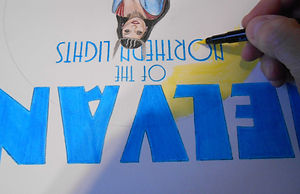

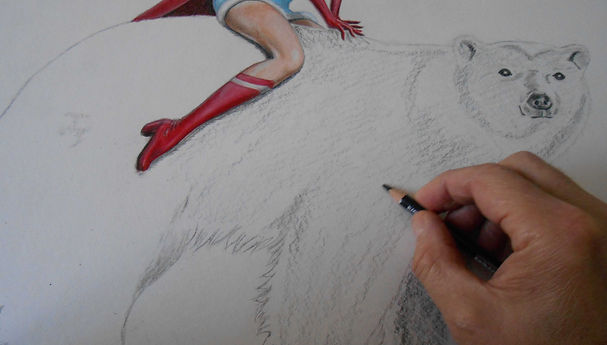

The latest of my pin-up posters is Nelvana of the Northern Lights. First appearing in Triumph-Adventure Comics #1 in 1941, Nelvana was created, written, and illustrated by Adrian Dingle, during a period when Golden Age Canadian comics enjoyed a brief surge of popularity at home largely due to the War Exchange Conservation Act, a wartime embargo placed on luxury goods from the US that was designed to address a serious trade imbalance between Canada and the United States.
Nelvana was a demi-goddess, the daughter of Koliak, King of the Northern Lights, and a mortal woman. At the behest of the Inuit, she arrives on Earth to fight evil where it may be – particularly where it might threaten the people of the north. Predating Wonder Woman, she was unusual in that she was portrayed as being more than simply set-dressing for the actions of the male characters surrounding. Indeed, by the measure of the day, she has to be considered to have been ahead of her time in terms of depictions of women, and in the comics was not forced to play a secondary role to a male figure.
Drawing on the mystical power of her father (visible as the Northern Lights), Nelvana had a slew of super human powers that enabled her to battle Nazis and various other villainous sorts throughout her brief career in the comic book world. She was a distinctly Canadian hero (the first one – male or female—in the comics) in a landscape dominated by America comics and their decidedly American heroes.
Unfortunately, like so much of Canadian culture, homegrown comics had a difficult time competing against their American brethren once the wartime embargo was lifted, and it wasn’t long before the likes of Nelvana and co vanished from the newsstands and from the Canadian consciousness. Only recently have the original stories printed in the Canadian “whites” been resurrected and reborn to a new generation of readers. (See Hope Nicolson's site.)
For my representation of Nelvana I drew upon the original Dingle material, adding a few tweaks of my own. In the original comics Nelvana’s brother, Tanero, appears as a great dane, which she sometimes rides on. I wanted something that was much more distinctly northern, so in my poster I’ve opted to feature Nelvana astride a polar bear. Her costume is much as it appeared in the original comics, with just a few adjustments.
This is a mixed media work on Canson 300g (140lbs) water colour paper, measuring 45.7cm X 61cm (18in X 24in). Nelvana was rendered using Prismacolor Premier colour pencils (blended with a Prismacolor blending pencil). The bear has a base of colour pencil, overlaid with white pastel, and then layered yet again with water colour and tempera paint to give some depth to the fur. Final details – such as the shading of the hairs – were added with colour pencils of various shades.
The title logo and sun/moon were done using Artist’s Loft Water Color Dual Tip Markers, and the sky a mix of marker and water colour paint. The snow and the ice upon which the bear is standing were painted using water colour paint. The completed was trimmed slightly (about two centimeters off the left side).
For a speed art/time lapse video – Drawing Nelvana of the Northern Lights – just follow the link or go to the video page of this section.
The Step-by-step

It begins with a rough, initial sketch to set the composition and pose.

The sketch is refined, with some details and basic shading rendered.

Basic highlights are applied to the figure before adding flesh tones atop the white.
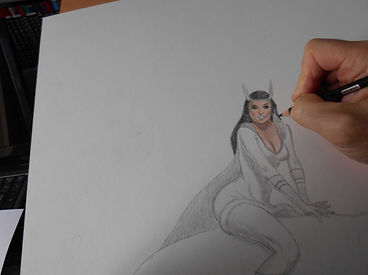
Flesh tones and details are added to the face, and the base color for the hair is applied.


All the exposed flesh is coloured, highlighted, shaded, and then blended.

Here I am using the blending pencil to smooth the colour pencil application.


The dress is coloured and the shading and highlighting blended in.

The cape is coloured and more detail is filled in.

Except for the headpiece, the figure is now largely complete.

Here I am adding some shading detail to the now coloured (silver) headpiece.
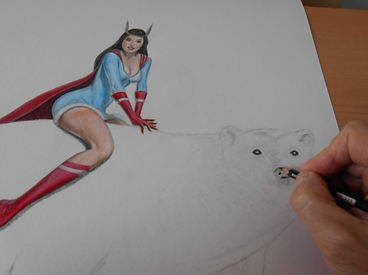
With Nelvana largely complete, it's time to move onto the polar bear. Here starting with some shading and facial details.


Here I am applying some base shading in colour pencil to the body of the bear. To give the bear some depth and heft, I will be applying several layers of different media.


The bear looking rather unpolar bearish after the colour pencil shading has been blended. Yeah, he doesn't look too good now, but art is all about patiently working a piece until you get what you want, so stay tuned.

See? He's already looking better after an application of pastel to soften the harshness of the shading.

Now I am applying tempera paint. Not in strokes, but rather stabbing at the paper. The effect further softens the look, but doesn't completely erase the undertones of shading. There's an almost translucent effect to it.

This is the bear after the application of paint.

Now I start adding other colours. A touch of ochre, a little burnt sienna, using the brush and paint to blend it all.

The bear has more depth, now, and is largely complete -- though there will be more tweaking later. From that I move to adding the title logo.

The water colour markers are first used to outline the logo, then to colour it in.


The completed title logo.

Now I move on to the sun/moon, using water colour markers again and topping this off with a layer of colour pencil in the same shade of yellow.


Water colour marker is used to colour around the letters and the sun/moon.
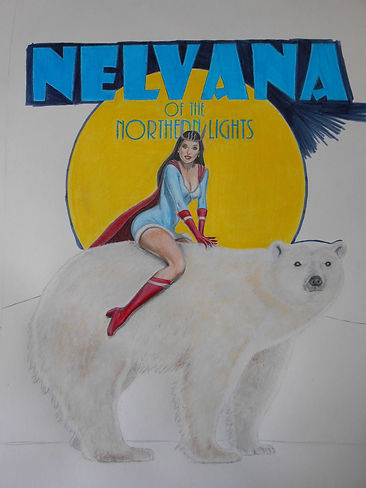
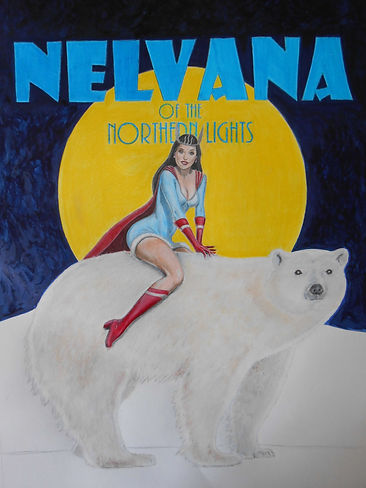
The background sky is completed using water colour paint and a brush. In this instance I opted not to make the sky a uniform solid colour, but to let the brush strokes show. This gives the picture more depth and character.

I use water colour and brush again to filled in the central ground of snow banks. Layers of water colour are used to render the ice the bear is standing on so as to give it a translucency and depth.



A few last tweaks here and there (like some black colour pencil shading around the edges of the bear's paws where they connect with the ice) and the poster is complete.